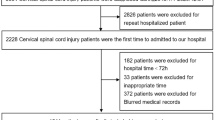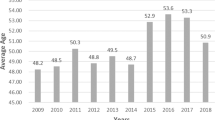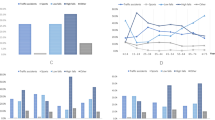Abstract
Study design
Retrospective study.
Objective
To investigate the outcomes and influencing factors of tracheostomy decannulation (TD) in persons with traumatic cervical spinal cord injury (SCI).
Setting
China Rehabilitation Research Center (CRRC) in Beijing, China.
Methods
From January 2017 to December 2021, 365 persons with traumatic cervical SCI were admitted to the China Rehabilitation Research Center. During hospitalization, tracheostomy patients were enrolled and divided into the TD group and non-TD group. Demographic and clinical data, as well as functional assessments, were collected and recorded for all persons. The factors influencing TD were analyzed using both univariate and multivariate logistic regression.
Results
A total of 78 persons with traumatic cervical SCI from CRRC were enrolled in this study. Of these, 48 persons (61.5%) underwent successful decannulation, with a median time of 93.5 days (IQR: 62.0–143.8 days). Multivariate logistic regression revealed that AIS A (P = 0.021, OR: 5.378, 95% CI, 1.287–22.474) and Charlson comorbidity index (CCI) (P = 0.003, OR: 1.836, 95% CI, 1.230–2.740) were significant risk factors of reduced success in TD. PEF in the TD group was 145.44 ± 50.56 L/min. Middle-aged and young persons with traumatic cervical SCI at C3 to C5 neurological level did not satisfy the criterion of PEF (over 160 L/min), but they can still attempt tracheostomy decannulation.
Conclusion
AIS A and a high CCI will reduce the success rate of tracheostomy decannulation in persons suffering from traumatic cervical SCI.
This is a preview of subscription content, access via your institution
Access options
Subscribe to this journal
Receive 12 print issues and online access
$259.00 per year
only $21.58 per issue
Buy this article
- Purchase on SpringerLink
- Instant access to full article PDF
Prices may be subject to local taxes which are calculated during checkout


Similar content being viewed by others
Data availability
The dataset generated and analyzed during the current study is available from the corresponding author upon reasonable request.
Change history
06 December 2024
In this article the author’s name Lianjun Gao was incorrectly written as Lianjun Guo.
09 December 2024
A Correction to this paper has been published: https://doi.org/10.1038/s41393-024-01050-0
References
Josefson C, Rekand T, Lundgren-Nilsson Å, Sunnerhagen KS. Respiratory complications during initial rehabilitation and survival following spinal cord injury in Sweden: a retrospective study. Spinal Cord. 2021;59:659–64.
Galeiras Vázquez R, Rascado Sedes P, Mourelo Fariña M, Montoto Marqués A, Ferreiro Velasco ME. Respiratory management in the patient with spinal cord injury. Biomed Res Int. 2013;2013:168757.
Farag E. Airway management for cervical spine surgery. Best Pract Res Clin Anaesthesiol. 2016;30:13–25.
Jones TS, Burlew CC, Johnson JL, Jones E, Kornblith LZ, Biffl WL, et al. Predictors of the necessity for early tracheostomy in patients with acute cervical spinal cord injury: a 15-year experience. Am J Surg. 2015;209:363–8.
Beom JY, Seo HY. The Need for Early Tracheostomy in Patients with Traumatic Cervical Cord Injury. Clin Orthop Surg. 2018;10:191–6.
Harrop JS, Sharan AD, Scheid EH, Vaccaro AR, Przybylski GJ. Tracheostomy placement in patients with complete cervical spinal cord injuries: American Spinal Injury Association Grade A. J Neurosurg Spine. 2004;100:20–23.
Foran SJ, Taran S, Singh JM, Kutsogiannis DJ, McCredie V. Timing of tracheostomy in acute traumatic spinal cord injury: A systematic review and meta-analysis. J Trauma Acute Care Surg. 2022;92:223–31.
Branco BC, Plurad D, Green DJ, Inaba K, Lam L, Cestero R, et al. Incidence and clinical predictors for tracheostomy after cervical spinal cord injury: a National Trauma Databank review. J Trauma. 2011;70:111–5.
Berney SC, Gordon IR, Opdam HI, Denehy L. A classification and regression tree to assist clinical decision making in airway management for patients with cervical spinal cord injury. Spinal Cord. 2011;49:244–50.
Gilony D, Gilboa D, Blumstein T, Murad H, Talmi YP, Kronenberg J, et al. Effects of tracheostomy on well-being and body-image perceptions. Otolaryngol-Head Neck Surg Off J Am Acad Otolaryngol-Head Neck Surg. 2005;133:366–71.
Durbin CG. Tracheostomy: why, when, and how? Respir Care. 2010;55:1056–68.
Fernandez-Bussy S, Mahajan B, Folch E, Caviedes I, Guerrero J, Majid A. Tracheostomy Tube Placement: Early and Late Complications. J Bronchol Interv Pulmonol. 2015;22:357–64.
Alizadeh A, Dyck SM, Karimi-Abdolrezaee S. Traumatic Spinal Cord Injury: An Overview of Pathophysiology, Models and Acute Injury Mechanisms. Front Neurol. 2019;10:282.
Lane MA, Fuller DD, White TE, Reier PJ. Respiratory neuroplasticity and cervical spinal cord injury: translational perspectives. Trends Neurosci. 2008;31:538–47.
Nakashima H, Yukawa Y, Imagama S, Ito K, Hida T, Machino M, et al. Characterizing the need for tracheostomy placement and decannulation after cervical spinal cord injury. Eur Spine J Off Publ Eur Spine Soc Eur Spinal Deform Soc Eur Sect Cerv Spine Res Soc. 2013;22:1526–32.
Kim DH, Kang SW, Choi WA, Oh HJ. Successful tracheostomy decannulation after complete or sensory incomplete cervical spinal cord injury. Spinal Cord. 2017;55:601–5.
Sun GH, Chen SW, MacEachern MP, Wang J. Successful decannulation of patients with traumatic spinal cord injury: A scoping review. J Spinal Cord Med. 2022;45:498–509.
Lee DS, Park CM, Carriere KC, Ahn J. Classification and regression tree model for predicting tracheostomy in patients with traumatic cervical spinal cord injury. Eur Spine J. 2017;26:2333–9.
Stelfox HT, Crimi C, Berra L, Noto A, Schmidt U, Bigatello LM, et al. Determinants of tracheostomy decannulation: an international survey. Crit Care Lond Engl. 2008;12:R26.
Chinese Expert Consensus on Tracheotomy and Extubation in Adults, Cardiopulmonary Rehabilitation Group of Physical Medicine and Rehabilitation Society, China, Critical Care Rehabilitation Committee, Chinese Society of Rehabilitation Medicine. Chinese Expert Consensus on Tracheotomy Extubation in Adults. Chin J Phys Med Rehabil. 2023;45:577–84.
Jianjun L, Mingliang Y, Degang Y, Feng G, Liangjie D, Limin L, et al. Expert Consensus on Evaluation, Treatment and Rehabilitation of Traumatic Spinal Cord Injury. Chin J Rehabil Theory Pract. 2017;23:274–87.
Gundogdu I, Ozturk EA, Umay E, Karaahmet OZ, Unlu E, Cakci A. Implementation of a respiratory rehabilitation protocol: weaning from the ventilator and tracheostomy in difficult-to-wean patients with spinal cord injury. Disabil Rehabil. 2017;39:1162–70.
Charlson ME, Pompei P, Ales KL, MacKenzie CR. A new method of classifying prognostic comorbidity in longitudinal studies: development and validation. J Chronic Dis. 1987;40:373–83.
Horn SD, Smout RJ, DeJong G, Dijkers MP, Hsieh C-H, Lammertse D, et al. Association of various comorbidity measures with spinal cord injury rehabilitation outcomes. Arch Phys Med Rehabil. 2013;94:S75–86.
Badhiwala JH, Wilson JR, Witiw CD, Harrop JS, Vaccaro AR, Aarabi B, et al. The influence of timing of surgical decompression for acute spinal cord injury: a pooled analysis of individual patient data. Lancet Neurol. 2021;20:117–26.
Higashi T, Eguchi H, Wakayama Y, Sumi M, Saito T, Inaba Y. Analysis of the risk factors for tracheostomy and decannulation after traumatic cervical spinal cord injury in an aging population. Spinal Cord. 2019;57:843–9.
Zhou T, Wang J, Zhang C, Zhang B, Guo H, Yang B, et al. Tracheostomy decannulation protocol in patients with prolonged tracheostomy referred to a rehabilitation hospital: a prospective cohort study. J Intensive Care. 2022;10:34.
Zheng H, Tang H, Zhang J, Hong Y, Xia Y, Sun H, et al. Respiratory management for patients undergoing tracheotomy after cervical spinal cord injury. Chin J Spine Spinal Cord. 2015;25:158–62.
Berlowitz DJ, Wadsworth B, Ross J. Respiratory problems and management in people with spinal cord injury. Breathe. 2016;12:328–40.
Schilero GJ, Spungen AM, Bauman WA, Radulovic M, Lesser M. Pulmonary function and spinal cord injury. Respir Physiol Neurobiol. 2009;166:129–41.
Dimar JR, Fisher C, Vaccaro AR, Okonkwo DO, Dvorak M, Fehlings M, et al. Predictors of complications after spinal stabilization of thoracolumbar spine injuries. J Trauma. 2010;69:1497–500.
Marylou G, Susan LG, Charles HB, Barry G, Sally AH, Lishan C. Predictors of pressure ulcer recurrence in veterans with spinal cord injury. J Spinal Cord Med. 2008;31:551–9.
Bub LD, Blackmore CC, Mann FA, Lomoschitz FM. Cervical spine fractures in patients 65 years and older: a clinical prediction rule for blunt trauma. Radiology. 2005;234:143–9.
Heidler M-D, Salzwedel A, Jöbges M, Lück O, Dohle C, Seifert M, et al. Decannulation of tracheotomized patients after long-term mechanical ventilation - results of a prospective multicentric study in German neurological early rehabilitation hospitals. BMC Anesthesiol. 2018;18:65.
Yekaninejad MS, Derakhshanrad N, Kazemi E, Derakhshanrad A, Saberi H. Influential factors for final neurorehabilitation outcome scores in patients with spinal cord injury: A longitudinal cohort study. J Neurorestoratology. 2024;12:100117.
Mueller G, Groot S, Woude L, Perret C, Michel F, Hopman M. Prediction models and development of an easy to use open-access tool for measuring lung function of individuals with motor complete spinal cord injury. J Rehabil Med. 2012;44:642–7.
Tran D, Rajwani K, Berlin DA. Pulmonary effects of aging. Curr Opin Anaesthesiol. 2018;31:19–23.
Bach JR, Saporito LR. Criteria for extubation and tracheostomy tube removal for patients with ventilatory failure. A different approach to weaning. Chest. 1996;110:1566–71.
Acknowledgements
We thank the staff of the Medical Record Room of the China Rehabilitation Research Center for their generous help. We would like to thank Mr. Li Peng Kun from the Statistics Office of the China Rehabilitation Research Center for guiding the statistical analysis.
Funding
Our research project was supported by the Research and Translation Application of the Capital’s Unique Clinical Diagnosis and Treatment Technology (No: Z221100007422024) and China Rehabilitation Research Center (No: 2023ZX-Q12).
Author information
Authors and Affiliations
Contributions
Xie Yongqi interpreted the results and wrote the manuscript. Zhao Weichao interpreted the data and revised the article. Peng Run and Zhang Liang were responsible for collecting the data. Jia Yunxiao analyzed the data and made figures and tables. Gao Lianjun was responsible for interpreting the results and providing funding support. Yang Mingliang provided funding support and did language modification. All authors contributed to the editorial process and approved the final version of the manuscript.
Corresponding authors
Ethics declarations
Competing interests
The authors declare no competing interests.
Ethics approval
The study was approved by the institution’s medical ethics committee (CRRC-IEC-RF-SC-002-01). And patient consent was not required as existing databases are used. This study followed the Declaration of Helsinki and the Guidelines for the Reporting of Observational Studies.
Additional information
Publisher’s note Springer Nature remains neutral with regard to jurisdictional claims in published maps and institutional affiliations.
The original online version of this article was revised: In this article the author’s name Lianjun Gao was incorrectly written as Lianjun Guo.
Supplementary information
Rights and permissions
Springer Nature or its licensor (e.g. a society or other partner) holds exclusive rights to this article under a publishing agreement with the author(s) or other rightsholder(s); author self-archiving of the accepted manuscript version of this article is solely governed by the terms of such publishing agreement and applicable law.
About this article
Cite this article
Xie, Y., Zhao, W., Peng, R. et al. The influencing factors for tracheostomy decannulation after traumatic cervical spinal cord injury: a retrospective study. Spinal Cord 63, 43–48 (2025). https://doi.org/10.1038/s41393-024-01048-8
Received:
Revised:
Accepted:
Published:
Issue date:
DOI: https://doi.org/10.1038/s41393-024-01048-8



